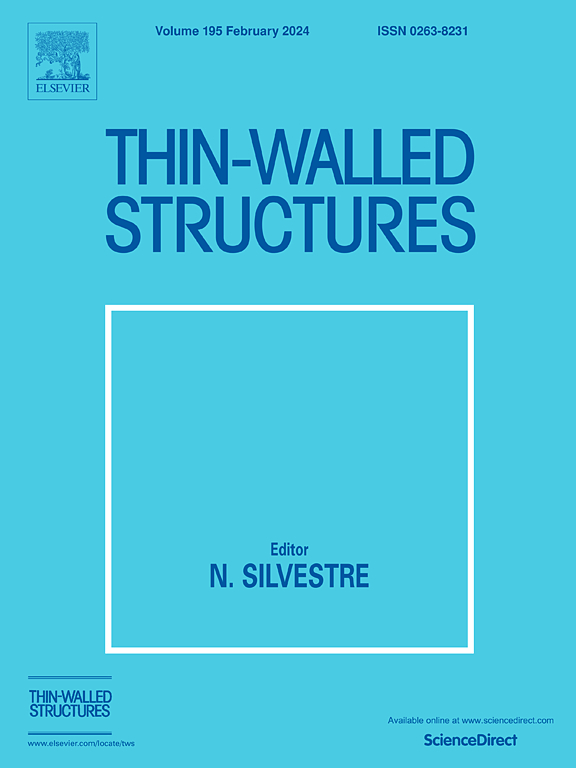Experimental investigation of innovative high-bearing and large-deformation steel plate shear wall utilizing trapezoidal corrugated panel
IF 5.7
1区 工程技术
Q1 ENGINEERING, CIVIL
引用次数: 0
Abstract
This paper proposed an innovative high-bearing, energy dissipation, and large ductile deformation corrugated steel plate shear wall (CSPSW) by utilizing a trapezoidal corrugated panel to replace traditional flat steel panel, to avoid steel panel buckling or relieve post-buckling bearing degradation with a certain displacement angle. A total of 8 CSPSW specimens with different aspect ratios (wall panel height to width ratio), panel thicknesses, corrugated sub-panel widths, and corrugation angles, were designed and experimentally investigated by quasi-static tests. The influence of different configuration parameters on the bearing, deformation, energy dissipation, and buckling characteristics, were analyzed. The results indicated that the load-deformation process of CSPSW exhibited 4 stages, including the linear-elastic stage, the yielding stage, the wall panel buckling stage, and the post-buckling fracture stage. With reasonable design of the configuration parameters, the CSPSW could achieve stable bearing capacity, avoiding shear buckling of the corrugated steel panel or exhibiting slight post-buckling bearing capacity degradation, thus achieving an equivalent damping coefficient exceeding 0.4. Additionally, decreasing the width-to-height ratio, width-to-thickness ratio, and sub-panel widths or increasing the corrugation angle of CSPSW's wall panel, was beneficial for achieving a larger buckling displacement angle, improving the post-yielding plastic overstrength, as well as relieving post-buckling bearing degradation and improving energy dissipation. It was suggested the width-to-thickness ratio within 150, the width-to-height ratio within 2.0, the sub-panel width-to-thickness ratio within 20, and the corrugation angle over 45°.
求助全文
约1分钟内获得全文
求助全文
来源期刊

Thin-Walled Structures
工程技术-工程:土木
CiteScore
9.60
自引率
20.30%
发文量
801
审稿时长
66 days
期刊介绍:
Thin-walled structures comprises an important and growing proportion of engineering construction with areas of application becoming increasingly diverse, ranging from aircraft, bridges, ships and oil rigs to storage vessels, industrial buildings and warehouses.
Many factors, including cost and weight economy, new materials and processes and the growth of powerful methods of analysis have contributed to this growth, and led to the need for a journal which concentrates specifically on structures in which problems arise due to the thinness of the walls. This field includes cold– formed sections, plate and shell structures, reinforced plastics structures and aluminium structures, and is of importance in many branches of engineering.
The primary criterion for consideration of papers in Thin–Walled Structures is that they must be concerned with thin–walled structures or the basic problems inherent in thin–walled structures. Provided this criterion is satisfied no restriction is placed on the type of construction, material or field of application. Papers on theory, experiment, design, etc., are published and it is expected that many papers will contain aspects of all three.
 求助内容:
求助内容: 应助结果提醒方式:
应助结果提醒方式:


